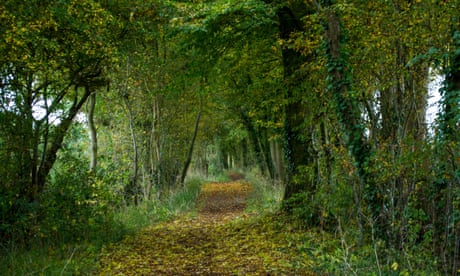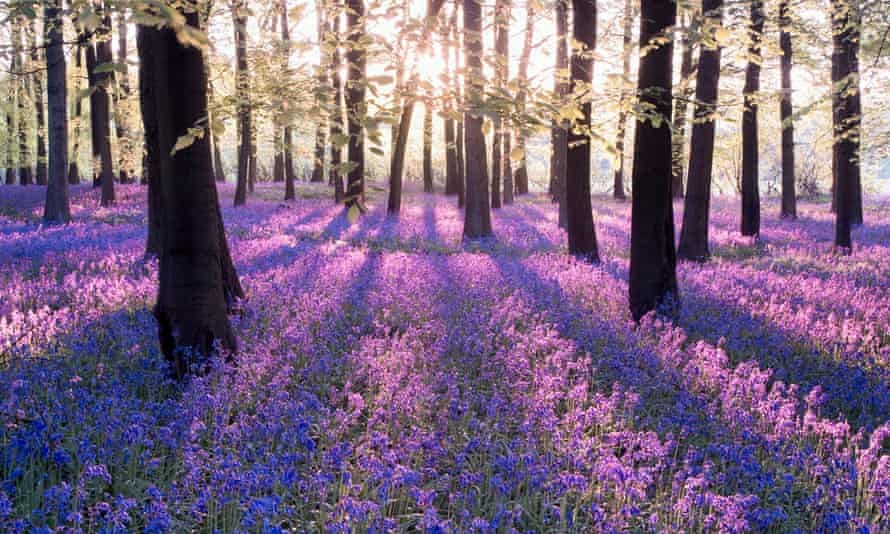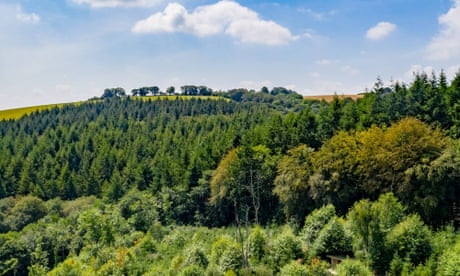Drive to plant more trees will count for little if existing woods are lost, says Woodland Trust
TREES ARE NOT ECOLOGY


Trees cut down at a woodland in the UK.Just 7% of the
country’s native woodland is in a good condition.
Environment editor
THE GUARDIAN
THE GUARDIAN
Wed 14 Apr 2021
The UK’s native woodlands are reaching a crisis point, with just 7% in good condition, according to the first comprehensive assessment of their health.
The Woodland Trust’s report found the woods facing a barrage of threats, including destruction by development, imported pests and diseases, the impacts of the climate crisis and pollution. Woodland specialist birds and butterflies have declined by almost half since 1970, it said.
The report said the high-profile drive to create new woodlands is important, but would count for little if existing woods are lost. In any case, the report said, rates of tree planting are nowhere near what is needed and less than half of the new trees are native species.
Trees should play an important role in helping the UK tackle the climate emergency and restore wildlife in one of the most nature-depleted countries in the world. They can also provide services such as reduced flooding and shade, as well as being important for many people’s wellbeing.
Woodland cover has nearly tripled since 1900 and makes up 13% of the UK, but half of this is forestry plantations that support relatively little biodiversity. In December, the UK’s Climate Change Committee said 2bn new trees would be needed by 2050, increasing the coverage to 18% of the country, and requiring a tripling of the growth rate.

Restore UK woodland by letting trees plant themselves, says report
Abi Bunker, the director of conservation at the Woodland Trust, said: “It’s reaching crisis point. The warning signs are loud and clear. If we don’t tackle the threats facing our woods and trees, we will severely damage the UK’s ability to address the climate and nature crises. Green spaces that are rich in wildlife, bird song and blossom are also intrinsically linked to our own health and wellbeing.”
The broadcaster Clive Anderson, who is the Woodland Trust’s president, said: “We remain one of the least wooded countries in Europe. Fragmentation of woods, loss of trees and the wildlife dependent on them has been brutal.”
The poor condition of 93% native woodlands was particularly striking, said Chris Reid, at the Woodland Trust, citing the assessment made in 2020 by the Forestry Commission’s research agency: “I was surprised it was quite so bad – it is pretty shocking.” Overgrazing and invasive species are among the causes.
The report said species including dead wood beetles, lily of the valley and the willow tit were in steep decline, with the latter down 94% since 1970. “New woodland is only going to fill up with wildlife if you have existing woodland that’s in good condition and is connected,” said Reid.

The UK’s native woodlands are reaching a crisis point, with just 7% in good condition, according to the first comprehensive assessment of their health.
The Woodland Trust’s report found the woods facing a barrage of threats, including destruction by development, imported pests and diseases, the impacts of the climate crisis and pollution. Woodland specialist birds and butterflies have declined by almost half since 1970, it said.
The report said the high-profile drive to create new woodlands is important, but would count for little if existing woods are lost. In any case, the report said, rates of tree planting are nowhere near what is needed and less than half of the new trees are native species.
Trees should play an important role in helping the UK tackle the climate emergency and restore wildlife in one of the most nature-depleted countries in the world. They can also provide services such as reduced flooding and shade, as well as being important for many people’s wellbeing.
Woodland cover has nearly tripled since 1900 and makes up 13% of the UK, but half of this is forestry plantations that support relatively little biodiversity. In December, the UK’s Climate Change Committee said 2bn new trees would be needed by 2050, increasing the coverage to 18% of the country, and requiring a tripling of the growth rate.

Restore UK woodland by letting trees plant themselves, says report
Abi Bunker, the director of conservation at the Woodland Trust, said: “It’s reaching crisis point. The warning signs are loud and clear. If we don’t tackle the threats facing our woods and trees, we will severely damage the UK’s ability to address the climate and nature crises. Green spaces that are rich in wildlife, bird song and blossom are also intrinsically linked to our own health and wellbeing.”
The broadcaster Clive Anderson, who is the Woodland Trust’s president, said: “We remain one of the least wooded countries in Europe. Fragmentation of woods, loss of trees and the wildlife dependent on them has been brutal.”
The poor condition of 93% native woodlands was particularly striking, said Chris Reid, at the Woodland Trust, citing the assessment made in 2020 by the Forestry Commission’s research agency: “I was surprised it was quite so bad – it is pretty shocking.” Overgrazing and invasive species are among the causes.
The report said species including dead wood beetles, lily of the valley and the willow tit were in steep decline, with the latter down 94% since 1970. “New woodland is only going to fill up with wildlife if you have existing woodland that’s in good condition and is connected,” said Reid.

Bluebells in a UK woodland during spring. Photograph: Woodland Trust/PA Media
The climate crisis is changing the timing of seasonal events, with trees coming into leaf earlier, the report said. This means birds such as the blue tit are struggling to adjust their breeding times to feed on caterpillars.
Centuries-old and wildlife-rich ancient forests cover 2.5% of the UK, but at least 1,225 of these woodlands are under threat of destruction by new building development, according to the Woodland Trust.
Individual trees in fields make up 20% of all trees, the report said, and can provide important staging posts for wildlife between woodlands. But research by the trust in Norfolk and Suffolk found 85% have been lost over last 150 years.
A single oak tree can play home to more than 2,000 different species, said Bunker, but there is little data on field trees: “The fact is no one really knows and no one’s checking – a lot of the time, they are forgotten trees.”

'It's good for the soul': the mini rewilders restoring UK woodland
The report also said 19 new damaging tree pests and diseases have become established in UK since 1990, compared with four in the previous 40 years. It said the 10-fold increase in live plant imports since 1990 was the likely cause. Ash dieback disease could kill 120m trees, the report said, meaning a cost of £50 for every £1 earned from importing saplings.
Nitrogen pollution from farming is another problem, causing clean air lichens to disappear from tree branches and nitrogen-tolerant grasses and plants to wipe out woodland flowers such as violets, bugle, heather and bilberry. “If you imagine every single tree branch covered in lichens, that’s a lot of carbon in itself,” said Hazel Jackson, at the Woodland Trust. “But they also slow the flow of water and are amazing habitat for lots of different insects.”
Protecting and enhancing woodlands, and founding new ones, is happening at smaller scales, said Bunker, but needs to be happening nationwide. She said the government’s environment bill must make the restoration of nature a legal requirement, as the 2050 net zero emissions goal is for climate change.
A spokeswoman for the Department for Environment, Food and Rural Affairs said: “We have committed to increase woodland creation across the UK to 30,000 hectares per year by 2025, as well as protecting existing woodlands.”
“We have already announced the Nature for Climate Fund and will shortly publish our action plan for trees and woodland, which will help us meet this target by ensuring we plant new high-quality, well-managed woodlands and improve the condition and resilience of existing ones,” she said.
The climate crisis is changing the timing of seasonal events, with trees coming into leaf earlier, the report said. This means birds such as the blue tit are struggling to adjust their breeding times to feed on caterpillars.
Centuries-old and wildlife-rich ancient forests cover 2.5% of the UK, but at least 1,225 of these woodlands are under threat of destruction by new building development, according to the Woodland Trust.
Individual trees in fields make up 20% of all trees, the report said, and can provide important staging posts for wildlife between woodlands. But research by the trust in Norfolk and Suffolk found 85% have been lost over last 150 years.
A single oak tree can play home to more than 2,000 different species, said Bunker, but there is little data on field trees: “The fact is no one really knows and no one’s checking – a lot of the time, they are forgotten trees.”

'It's good for the soul': the mini rewilders restoring UK woodland
The report also said 19 new damaging tree pests and diseases have become established in UK since 1990, compared with four in the previous 40 years. It said the 10-fold increase in live plant imports since 1990 was the likely cause. Ash dieback disease could kill 120m trees, the report said, meaning a cost of £50 for every £1 earned from importing saplings.
Nitrogen pollution from farming is another problem, causing clean air lichens to disappear from tree branches and nitrogen-tolerant grasses and plants to wipe out woodland flowers such as violets, bugle, heather and bilberry. “If you imagine every single tree branch covered in lichens, that’s a lot of carbon in itself,” said Hazel Jackson, at the Woodland Trust. “But they also slow the flow of water and are amazing habitat for lots of different insects.”
Protecting and enhancing woodlands, and founding new ones, is happening at smaller scales, said Bunker, but needs to be happening nationwide. She said the government’s environment bill must make the restoration of nature a legal requirement, as the 2050 net zero emissions goal is for climate change.
A spokeswoman for the Department for Environment, Food and Rural Affairs said: “We have committed to increase woodland creation across the UK to 30,000 hectares per year by 2025, as well as protecting existing woodlands.”
“We have already announced the Nature for Climate Fund and will shortly publish our action plan for trees and woodland, which will help us meet this target by ensuring we plant new high-quality, well-managed woodlands and improve the condition and resilience of existing ones,” she said.
No comments:
Post a Comment